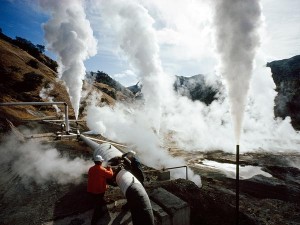Coming off a year of record expansion in 2012, the geothermal industry will have an even better year in 2013 as more plants than ever before come online.
While part of the rush is temporary, with developers rushing to start construction before a tax credit deadline at the end of the year, growing interest in geothermal is not going away anytime soon, according to Karl Gawell, executive director of the Geothermal Energy Association.
This year through 2015 “will be three of the most significant boom years for geothermal in decades,” according to the association’s latest production and energy report.

The Geysers, located in the Mayacamas Mountains north of San Francisco, California, is the United States’ first geothermal power plant
The boom started in 2012 when five companies including US Geothermal and Ormat Technologies completed seven new plants with a combined 147 megawatts in new capacity. That may be especially good news for JP Morgan, which in January paid $35.7 million for an ownership stake in eight Ormat plants, plus another $8.7 million for a quarter of the production tax credits generated by those plants through 2016, Bloomberg reported.
The building spree will continue next year, when 14 new plants should be completed, plus another 19 facilities predicted to come online in the following two years. All totaled, there are 175 geothermal projects currently at some stage of development across 13 states, from preliminary exploration through advanced stage construction, the report found.
California will remain the dominant producer of geothermal electricity for some time to come. But growth will be strongest in Oregon, where companies including Ormat Technologies and US Geothermal have over 200 megawatts of geothermal capacity under development.
“So it looks like growth will continue for the next couple of years,” Gawell said in a conference call with reporters.
New Tech for a Resource that’s Old as Dirt
Oregon’s surging growth rate is appropriate given that it’s home to one of the most advanced geothermal projects in the country. With $26 million in investment from Microsoft billionaire Paul Allen’s investment firm Vulcan Capital, plus Google, Kleiner Perkins and Khosla Ventures, a startup called AltaRock has successfully built an Enhanced Geothermal System (EGS) plant near Bend, Oregon.
The development involves drilling four miles into the earth, fractured the bedrock, and artificially pumping water across the hot rock to create steam. Whereas traditional geothermal plants are limited to areas where high underground temperatures and water reservoirs appear naturally together close to the surface, EGS technology could make this renewable resource affordable on a much broader scale.
“What Enhanced Geothermal Systems will do is open up geothermal to the whole United States,” says Tom Williams, manager of the geothermal program at the National Renewable Energy Laboratory. “So the total potential becomes enough to power the entire electric grid many times over if it were fully developed.”
Another opportunity is to piggyback on oil and gas drilling fields, building new geothermal resources using waste liquids created by the drilling process itself to heat water and create steam. This opportunity “is substantial,” Gawell says, “and it brings us to whole new regions from the Gulf of Mexico to the Dakotas, displacing power that the oil companies are now buying form the grid.”
Investment Outlook
Both deep-well and cogeneration plants remain experimental technologies that still take years of R&D. In the meantime, it’s not that financing traditional geothermal is impossible, says Doug Glaspey, President of U.S. Geothermal. But it certainly isn’t easy.
“The equity markets are still very tight,” Glaspey says. “But if you have a good project, you have the wells drilled, you have a resource, and you have a PPA in hand, there’s still money out there to build a project.”
That’s a lot of hurdles to jump, especially in an industry where each well costs $5 to $6 million to drill, says Glaspey, and when developing a new resource involves a series of high-risk maneuvers including determining whether and how steam can be most efficiently generated and converted to electricity, according to a landmark study by MIT.

The Svartsengi geothermal power plant in Iceland
Nevertheless, some of the industry’s larger players have experienced a stock price revival in recent quarters. Before its deal with JP Morgan was announced, Ormat Technologies beat expectations on revenues and earnings per share in November, plus announced it would purchase a geothermal plant in Honduras, which led to an upgrade of the company’s stock by Barclays.
The same week, U.S. Geothermal announced it received a $10.7 million tax credit cash grant from the U.S. Treasury. By December the company announced it had all three modules of its new Neal Hot Springs plant up and running, which resulted in a 30-percent uptick in its stock price.
Regulatory Help and Hurdles
For projects that may be years away from going online, many geothermal companies are actively pursuing deals under state Renewable Portfolio Standards, which have become important ways to bridge the gap between early exploration and online power generation.
“To increase the financing for geothermal we need to see that PPA market grow or create demand again within the state RPS’s, so projects can get the early funding they need to get started,” says Paul Thomsen, lobbyist and director of business development for Ormat Technologies.
Perhaps counter-intuitively, recent drops in the price of electricity could actually help that commercialization process. As the natural gas boom drives electricity costs down by three or four percent, Thomsen says, local power utilities and state legislatures now can afford the 1-percent surcharge that typically accompanies switching from traditional fuels like coal to geothermal without incurring the ratepayers’ wrath
“When states are looking for an opportunity to invest in the long term for projects with a 20-year timeframe with very little volatility, there’s an opportunity to do it now while there are declining retail rates on the consumer,” Thomsen says.
At the federal level, Gawell says that many industry analysts underestimate the importance of Congress’s decision last year to extend production tax credits so that any project that starts construction in 2013 can qualify. The previous rule required plants to be online before they could receive the credits.
Some uncertainty still lingers, however.
“The question people are facing is how the Treasury Department is going to interpret that “under construction?” Gawell says.
Such concerns underscore the importance of consistent support from policymakers, says Gawell. In the White House, support is “pretty consistent from this administration,” Gawell says. There’s even a solid minority of Republicans on the House Ways and Means Committee that favors keeping current tax credits on renewable energy.
Continued gridlock in Washington means continued policy risk, however. Tax reform could spell an end to production, Gawell says. On the other hand, a process of rationalizing tax policies that benefit the oil and gas industries to the exclusion of renewables, such as accelerated depreciation, could be a boon for geothermal investors.
“I think that’s a compelling shift,” Thomsen says. “How do we get into the mainstream of oil and gas taxation policy?”
Even as it prepares for its largest growth period ever, the U.S. geothermal industry still suffers from public misconceptions about how the technology works. At an Earth Day event on the National Mall in 2000, the geothermal association asked passersby a question that’s fundamental to geothermal: Is the center Earth hot or cold?
“The majority of people…said cold,” Gawell says. “There are a lot of misunderstandings (about geothermal), and it’s really deeply rooted.”